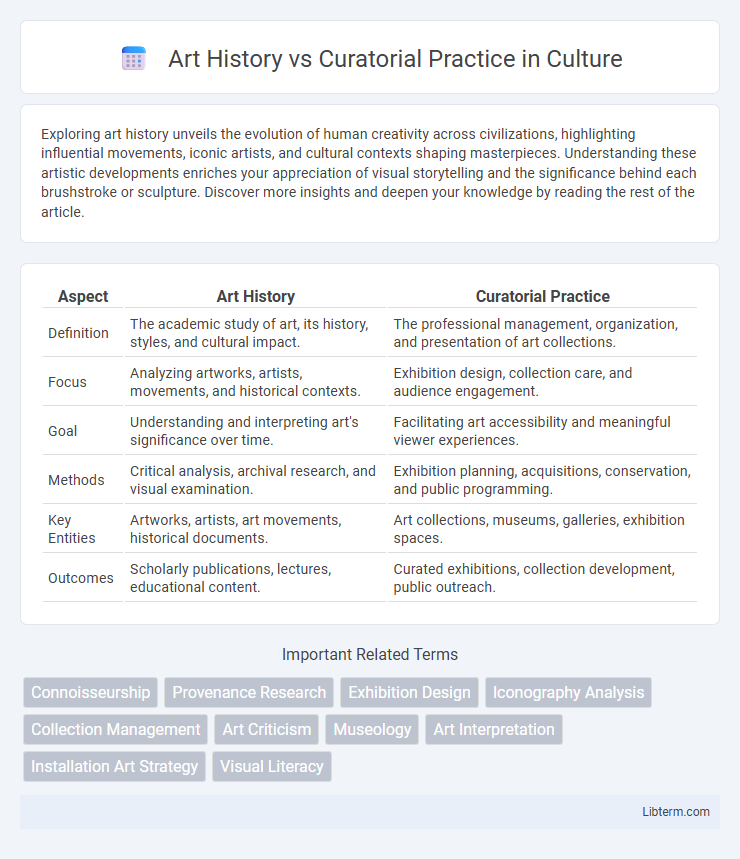Exploring art history unveils the evolution of human creativity across civilizations, highlighting influential movements, iconic artists, and cultural contexts shaping masterpieces. Understanding these artistic developments enriches your appreciation of visual storytelling and the significance behind each brushstroke or sculpture. Discover more insights and deepen your knowledge by reading the rest of the article.
Table of Comparison
| Aspect | Art History | Curatorial Practice |
|---|---|---|
| Definition | The academic study of art, its history, styles, and cultural impact. | The professional management, organization, and presentation of art collections. |
| Focus | Analyzing artworks, artists, movements, and historical contexts. | Exhibition design, collection care, and audience engagement. |
| Goal | Understanding and interpreting art's significance over time. | Facilitating art accessibility and meaningful viewer experiences. |
| Methods | Critical analysis, archival research, and visual examination. | Exhibition planning, acquisitions, conservation, and public programming. |
| Key Entities | Artworks, artists, art movements, historical documents. | Art collections, museums, galleries, exhibition spaces. |
| Outcomes | Scholarly publications, lectures, educational content. | Curated exhibitions, collection development, public outreach. |
Introduction to Art History and Curatorial Practice
Introduction to Art History explores the development, context, and interpretation of visual art across cultures and time periods, emphasizing critical analysis of artistic styles, movements, and iconography. Curatorial Practice focuses on the management, exhibition, and preservation of art collections, integrating research skills with practical experience in designing exhibitions and engaging audiences. Both disciplines intersect through their shared goal of deepening public understanding and appreciation of art, though Art History centers on academic scholarship while Curatorial Practice emphasizes applied museum and gallery work.
Defining Art History: Scope and Focus
Art History encompasses the systematic study of artworks, artists, and visual culture across different periods, emphasizing historical context, stylistic developments, and cultural significance. It analyzes movements such as Renaissance, Baroque, Modernism, and Postmodernism, investigating the socio-political influences that shape artistic expression. The discipline employs methodologies including formal analysis, iconography, and critical theory to interpret art's evolving meanings and functions over time.
Curatorial Practice Explained
Curatorial practice involves the strategic selection, organization, and presentation of artworks to create meaningful exhibitions that engage diverse audiences. It requires expertise in art history, audience insight, and logistical coordination to balance artistic vision with practical constraints. Effective curators shape cultural narratives by contextualizing art within historical, social, and theoretical frameworks, enhancing public understanding and appreciation.
Academic Foundations: Study Paths and Methodologies
Art History emphasizes critical analysis and historical context through methodologies such as visual analysis, iconography, and archival research, providing a strong academic foundation rooted in humanities scholarship. Curatorial Practice combines theoretical knowledge with practical skills including exhibition design, collection management, and public engagement, often integrating internships or hands-on training in museum environments. Both fields require rigorous study paths, but Art History graduates typically pursue advanced degrees focusing on research, while Curatorial Practice often involves professional certifications and experiential learning for direct application in galleries or museums.
Key Skills: Art Historians vs Curators
Art historians excel in critical analysis, interpretation of visual culture, and contextualizing artworks within historical frameworks, leveraging skills in research, writing, and theory. Curators specialize in collection management, exhibition design, and public engagement, emphasizing organizational skills, conservation knowledge, and communicative ability. Both roles require deep art knowledge but differ as art historians prioritize academic scholarship while curators focus on practical exhibition and collection stewardship.
Roles and Responsibilities in Museums and Galleries
Art historians analyze and interpret artworks to uncover historical context, stylistic developments, and cultural significance, providing essential scholarly research for museums and galleries. Curators are responsible for selecting, organizing, and managing exhibitions, overseeing collections, and facilitating educational programming to enhance visitor engagement. Both roles collaborate closely to ensure accurate representation and preservation of art while promoting public access and appreciation.
Research Approaches: Comparative Analysis
Art history research emphasizes contextual analysis, tracing artistic movements, styles, and cultural influences through archival materials and critical theory. Curatorial practice prioritizes audience engagement and exhibition narratives, employing research methods that integrate spatial design, object interpretation, and visitor experience. Comparative analysis reveals art history's theoretical framework supports curatorial decisions by providing historical depth, while curatorial research transforms scholarly knowledge into accessible, tangible presentations.
The Impact on Art Interpretation and Public Engagement
Art History provides critical frameworks and contextual analysis that deepen understanding of artworks, shaping scholarly interpretation and influencing curatorial narratives. Curatorial Practice transforms these insights into dynamic exhibition designs and interactive experiences that engage diverse audiences and foster public dialogue. The synergy between Art History and Curatorial Practice enhances both the intellectual appreciation and accessibility of art, broadening its cultural impact.
Career Opportunities: Art History vs Curatorial Practice
Art History offers diverse career opportunities including roles as museum educators, art critics, and academic researchers, emphasizing critical analysis and historical context of artworks. Curatorial Practice focuses on hands-on experience managing art collections, exhibition planning, and gallery administration, leading to careers as curators, exhibition managers, or collection specialists. Both fields provide pathways to professional roles within museums, galleries, auction houses, and cultural institutions, with Curatorial Practice concentrating more on operational expertise.
Future Trends in the Fields
Emerging technologies like AI and virtual reality are revolutionizing both art history and curatorial practice by enabling immersive exhibitions and advanced data analysis of artworks. The integration of digital archives and blockchain for provenance tracking is enhancing transparency and accessibility in curatorial workflows. Interdisciplinary collaboration between art historians, technologists, and curators is creating dynamic, interactive experiences that redefine audience engagement and education in art institutions.
Art History Infographic

 libterm.com
libterm.com